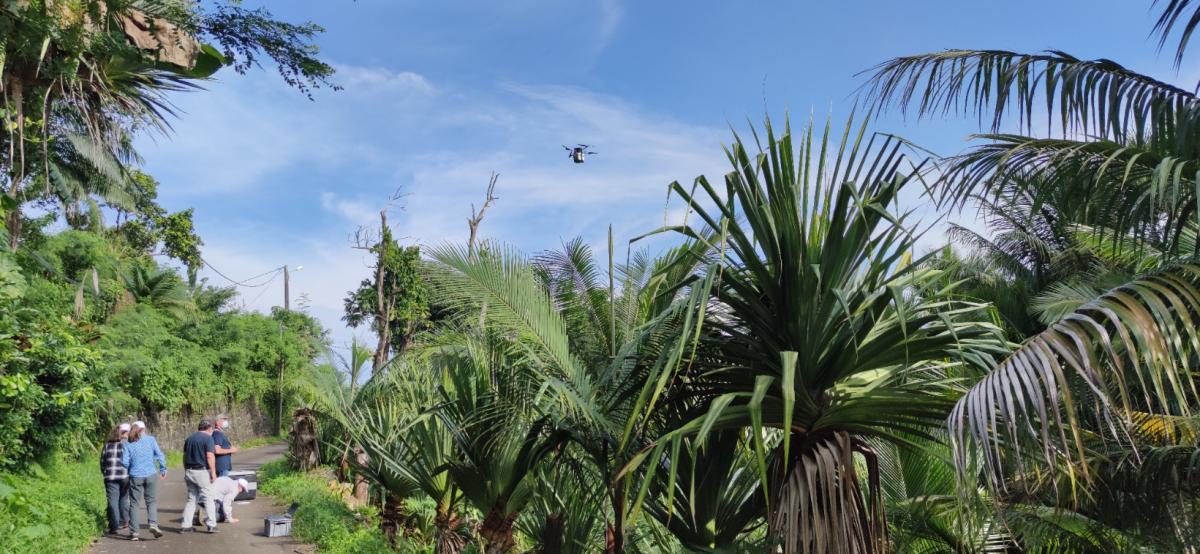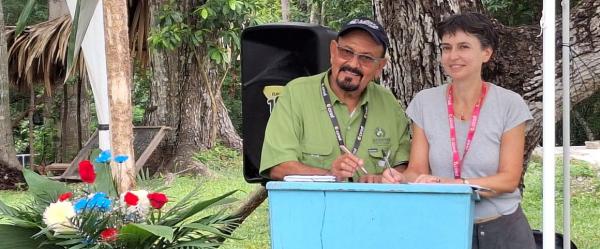Science at work 16 December 2025
- Home
- Press area
- Press releases
- Drone release of sterile mosquitoes
Dengue control: the first drone release of sterile mosquitoes in Réunion

The first drone release of sterile male mosquitoes took place in Réunion in an isolated site in the municipality of Saint-Joseph on 4 May 2021. © Saint-Joseph town council
This is the first time that boosted SIT and the use of drones to release sterile male mosquitoes has been field-tested in an urban area.
These pilot tests target the established vector of dengue and chikungunya in Réunion: Aedes aegypti. “Two study sites on the coast in the municipality of Saint-Joseph have been selected, since the populations of Aedes aegypti found there are isolated, which could mean they can be eliminated locally”, explains Jérémy Bouyer, an entomologist at CIRAD and coordinator of the REVOLINC project.
The pilot tests entail two phases, from April to August 2021:
• A first mark-release-recapture phase began in April: during this phase of six releases, 10 000 sterile male mosquitoes are being released every week in order to estimate their survival, dispersal, and mating competitiveness with wild mosquitoes. Two release techniques are being tested: on the ground and then by drone (from 4 May 2021).
• The best release technique will be selected in the second phase of control, which will take place after providing feedback to representatives and inhabitants of Saint-Joseph, as well as to the Regional Health Authority (ARS) and the Departmental Council for the Environment and Health and Technological Risks (CODERST). This phase will correspond to the release of 50 000 sterile males per week.
Over two weeks, teams from Saint-Joseph town council and CIRAD went door-to-door to inform the 200 or so local households of the upcoming operation, in order to answer any questions they might have (see questions / answers below).
These trials complement those conducted by IRD to control the main vector of dengue, Aedes albopictus, in the municipality of Sainte-Marie. The REVOLINC project aims to show that boosted SIT can be used to locally eliminate a relatively isolated vector, as is the case of Aedes aegypti in Réunion. The goal is to avoid the recolonisation of ecological niches of Aedes albopictus by Aedes aegypti. “If these trials are successful on localised Aedes aegypti populations, then this solution could be implemented on a larger scale”, says Jérémy Bouyer.
A review of these pilot tests will be made in August and the results provided to all of the actors concerned. If these results are positive, the boosted SIT approach and drone releases could then also be used longer term against Aedes albopictus in Réunion.
The sterile insect technique (SIT) is a vector control method in which large numbers of male mosquitoes are reared, then sterilised using irradiation before being released into the field, where they subsequently sterilise wild females. If applied for a sufficient length of time, this birth control method reduces the target mosquito population.
In the context of the REVOLINC project coordinated by CIRAD and involving IRD, the joint FAO-IAEA Insect Pest Control Section, as well as a number of partners in France (INRAE, University of Montpellier, University of Strasbourg) and abroad (Tragsa Spain, University of Manitoba, IAEA Vienna), boosted SIT is assessed in the field against Aedes mosquitoes, which are vectors of arboviruses such as dengue and chikungunya: Aedes albopictus in Valencia, Spain, and Aedes aegypti in Saint-Joseph, Réunion.
With the boosted sterile insect technique, male mosquitoes are coated prior to release with a biocide that they transfer to females during mating or through simple contact. These biocides kill their progeny.
The biocide used is pyriproxyfen, a growth regulator that interferes during the reproduction phases to inhibit adult emergence in the target species, and amplifies the effect sought through SIT. The doses of pyriproxyfen used on the sterile males released are very low and are not harmful to humans or the environment.
Questions / answers:
Where do the mosquitoes used come from?
The sterile male mosquitoes are reared in the FAO-IAEA insect pest control laboratory in Austria, using a strain from Réunion provided by ARS Réunion. These mosquitoes are then shipped to Saint-Joseph for the boosted SIT pilot tests by FedEx express, using a secure transport system tested by the FAO-IAEA laboratory, with triple packaging and refrigeration at 10°C to ensure they sleep during transport.
The release of coated sterile male mosquitoes is harmless:
• Only female mosquitoes bite, not males.
• Sterile insects cannot reproduce and cannot therefore become established in the environment.
• SIT does not introduce any exotic species into an ecosystem.
• Sterile mosquitoes are not genetically modified organisms.
• Male mosquitoes sterilised by irradiation are not harmful to humans: they are not radioactive.
• The doses of pyriproxyfen used on sterile males are very low and are not harmful to humans or the environment.
• Interrupting the reproductive cycle of insect vectors, also known as autocidal control, is by definition species-specific.
Drone releases
For its releases of coated sterile male mosquitoes, the ERC REVOLINC project meets all EU regulations and standards required for the use of drones. A certified and registered drone pilot is in charge of releases. An authorisation request was made to the Indian Ocean civil aviation directorate. The goal of these releases of sterile male mosquitoes is not to eradicate the target species, Aedes aegypti, in Réunion, but rather to locally eliminate an isolated population of these mosquitoes.



























